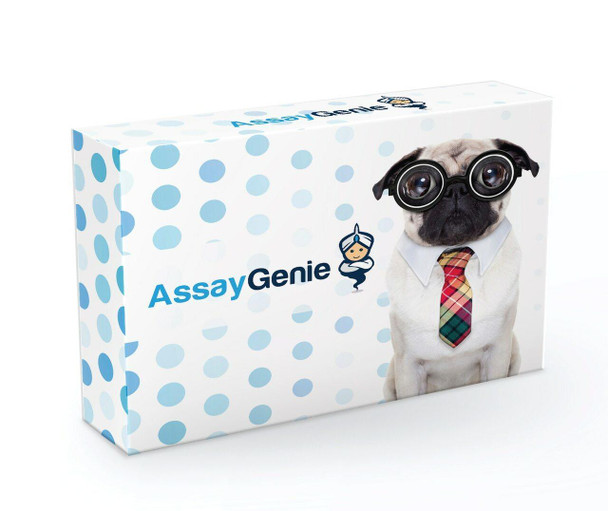Anti-FABP4 Antibody (RACO0182)
- SKU:
- RACO0182
- Product type:
- Recombinant Antibody
- Reactivity:
- Human
- Host Species:
- Human
- Isotype:
- IgG
- Application:
- ELISA
- Conjugation:
- Unconjugated
Frequently bought together:
Description
| 商品名: | FABP4 Antibody |
| Product SKU: | RACO0182 |
| サイズ: | 50ul |
| 宿主種: | Human |
| 申し込み: | ELISA |
| 推奨される希釈: | |
| 反応性: | Human |
| 免疫原: | A synthesized peptide derived from human FABP4 |
| 憲法: | Liquid |
| ストレージバッファ: | Rabbit IgG in phosphate buffered saline , pH 7.4, 150mM NaCl, 0.02% sodium azide and 50% glycerol. |
| 精製方法: | Affinity-chromatography |
| 抗体のクローン性: | Monoclonal |
| アイソタイプ: | Rabbit IgG |
| Conjugate: | Non-conjugated |
| バックグラウンド: | Lipid transport protein in adipocytes. Binds both long chain fatty acids and retinoic acid. Delivers long-chain fatty acids and retinoic acid to their cognate receptors in the nucleus. |
| シノニム: | Fatty acid-binding protein, adipocyte, Adipocyte lipid-binding protein, ALBP, Adipocyte-type fatty acid-binding protein, A-FABP, AFABP, Fatty acid-binding protein 4, FABP4 |
| UniProt Protein Function: | FABP4: a lipid transport protein that is the predominant fatty acid binding protein found in adipocytes. Also expressed in macrophages. Binds both long chain fatty acids and retinoic acid. Delivers long-chain fatty acids and retinoic acid to their cognate receptors in the nucleus. Homodimer. Forms a beta-barrel structure that accommodates hydrophobic ligands in its interior. Interacts with PPARG. Monomer. FABP4 knockout mice fed a high-fat and high-calorie diet become obese but develop neither insulin resistance nor diabetes, suggesting that this protein might be a link between obesity and insulin resistance and diabetes. Mice deficient in both FABP4 and ApoE show protection against atherosclerosis when compared with mice deficient only in ApoE. Mice carrying a FABP4 genetic variant exhibit both reduced FABP4 expression and a reduced potential for developing type 2 diabetes and coronary heart disease. A related study in humans indicated a similar pattern, suggesting that FABP4 may be a potential therapeutic target in the treatment of these disorders. Belongs to the calycin superfamily,fatty-acid binding protein (FABP) family. |
| UniProt Protein Details: | Protein type:Lipid-binding Chromosomal Location of Human Ortholog: 8q21 Cellular Component: cytoplasm; lipid particle; nucleus Molecular Function:transporter activity; fatty acid binding Biological Process: cholesterol homeostasis; transport; white fat cell differentiation; triacylglycerol catabolic process; brown fat cell differentiation; negative regulation of protein kinase activity; cytokine production; negative regulation of transcription, DNA-dependent; positive regulation of inflammatory response |
| NCBI Summary: | FABP4 encodes the fatty acid binding protein found in adipocytes. Fatty acid binding proteins are a family of small, highly conserved, cytoplasmic proteins that bind long-chain fatty acids and other hydrophobic ligands. It is thought that FABPs roles include fatty acid uptake, transport, and metabolism. [provided by RefSeq, Jul 2008] |
| UniProt Code: | P15090 |
| NCBI GenInfo Identifier: | 119781 |
| NCBI Gene ID: | 2167 |
| NCBI Accession: | P15090.3 |
| UniProt Secondary Accession: | P15090,Q6IBA1, |
| UniProt Related Accession: | P15090 |
| Molecular Weight: | 132 |
| NCBI Full Name: | Fatty acid-binding protein, adipocyte |
| NCBI Synonym Full Names: | fatty acid binding protein 4, adipocyte |
| NCBI Official Symbol: | FABP4 |
| NCBI Official Synonym Symbols: | aP2; ALBP; AFABP; A-FABP; HEL-S-104 |
| NCBI Protein Information: | fatty acid-binding protein, adipocyte; fatty acid-binding protein 4; adipocyte lipid-binding protein; epididymis secretory protein Li 104; adipocyte-type fatty acid-binding protein |
| UniProt Protein Name: | Fatty acid-binding protein, adipocyte |
| UniProt Synonym Protein Names: | Adipocyte lipid-binding protein; ALBP; Adipocyte-type fatty acid-binding protein; A-FABP; AFABP; Fatty acid-binding protein 4 |
| Protein Family: | Fatty acid-binding protein |
| UniProt Gene Name: | FABP4 |
| UniProt Entry Name: | FABP4_HUMAN |

